Selecting iCloud Drive and Local Storage on Mac
Local storage offers fast, free, and offline access, ideal for privacy-conscious users. iCloud Drive provides device integration, synchronization, and cloud storage balancing, but requires a stable internet connection. A hybrid approach using both can optimize workflows based on specific needs. Local storage is free and faster, while iCloud Drive offers convenience and redundancy. Both methods have their advantages, and the best choice depends on the user's needs and internet availability.

Differences?
Local storage means saving everything on a computer. Whether it's a traditional HDD or a fast SSD, it allows you to access these files without an internet connection, limited only by your Mac's physical storage capacity. It works even without a connection; your files are always there.
Using iCloud Drive, files are pushed to Apple's servers and synchronized across devices as needed. Editing documents on your Mac and seeing changes reflected on your iPad almost instantly. Very convenient, but requires a stable internet connection to function properly. iCloud Drive automatically balances cloud and local storage. When you open a file, macOS downloads and keeps a local copy, making it accessible quickly. When the drive is full, macOS automatically deletes old and unused local copies, saving them to iCloud in the background—without you knowing. This means that files may not be available offline when using iCloud Drive, but exceptions apply to files accessed frequently.Why Continue with Local Storage?
While iCloud Drive is convenient, local storage offers many appealing benefits and is often the preferred choice. First and foremost, it's completely free, without monthly subscription fees or storage limits that exceed your Mac's physical capacity. This is crucial for handling large files like video or complex project folders that could quickly consume iCloud's storage tiers. Speed is another significant factor. Local storage provides consistent, fast access to files without depending on downloads, buffering, or internet bandwidth. Imagine your music library. If each song is stored in the cloud, listening to a playlist could become a potentially difficult process. iCloud Drive doesn't offer the same level of optimization as streaming services, so a similar experience is not possible. However, when saved locally, each song plays as expected. Privacy-conscious users may prefer local storage because files remain on their personal devices. Apple maintains strong security measures for iCloud, but cloud storage always comes with inherent risks. Many backup solutions exist, including Time Machine, so backup and privacy are not mutually exclusive. In fact, local backups often offer more customization and control advantages. Local storage ensures constant access to files regardless of internet connection status, which is particularly important for frequent travelers or those working in unstable internet regions. Many airlines and hotels provide Wi-Fi, but some offer it for free. However, the speed is often insufficient for actual work. This is not an issue when files are saved locally.Neither?
As mentioned earlier, there's no need to choose just one storage method. In fact, using both storage options can often provide the best experience. This dual-layer storage approach acts like having both a file cabinet and a locked safe in an office. The key to making this dual-layer storage approach work is to align it with your workflow and optimize efficiency as needed. Setting up a hybrid approach is straightforward. In System Preferences, under Apple ID > iCloud, select which folders to sync with iCloud Drive. Many users sync their desktop and documents folders so they can access them easily from anywhere, saving large media files locally to free up iCloud storage space. Consider creating specific purpose folders—like a "Current Project" folder to keep the fastest-access files locally and a "Completed Projects" folder to sync for backup and easy sharing on iCloud. You can force macOS to use both the local and cloud versions of files saved in iCloud Drive. Right-click the file and select "Keep in iCloud" to prevent macOS from deleting it during storage optimization. Your storage strategy may change as your needs evolve. Start with a simple system and adjust based on experience. Pay attention to which files are accessed most frequently and how you use different devices throughout the day. The purpose of cloud storage is to simplify your life, and with iCloud Drive, you should be able to achieve that goal regardless of your daily routine. The beauty of modern macOS lies in how it makes managing these storage systems very easy. You can find files in Finder whether they are stored locally or on iCloud Drive. The only thing to note is that sometimes, an indicator showing the download progress of recently visited cloud storage files will appear. Ultimately, finding the right balance is key.カテゴリー
最新記事
- 静かなキーストロークと高い生産性の向上を実現する、STEALTH KEYBOARD SM3 メカニカルキーボードのレビュー。
- その古い電話が目の前で火事の原因になった。
- アップル招待とアップルカレンダーの違い:10個のポイント
- アップル @ ワーク:2025年にアップルがGoogle Workspaceに対抗する製品をリリースするのか?
- Apple は iPhone SE 4 を発表する特別なイベントを開催する可能性が低い。
- 今日の NYT Connections ヒントと解答 (2 月 8 日 #608)
- Ubuntu 20.04 LTS のサポートが終了します。
- 読み込みが間に合わない? AI に読んでもらいたいですか?
- これは私が愛用する聖杯 ブルーレイプレーヤーです。
- 来週、新しい Apple 製品の発表が予定されています。詳細は下記の通りです。



